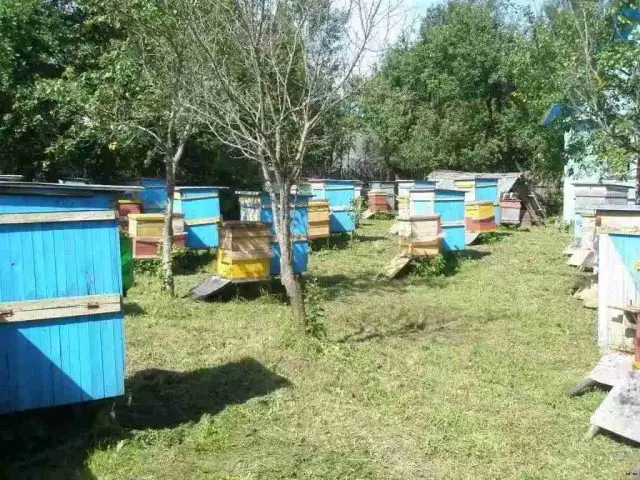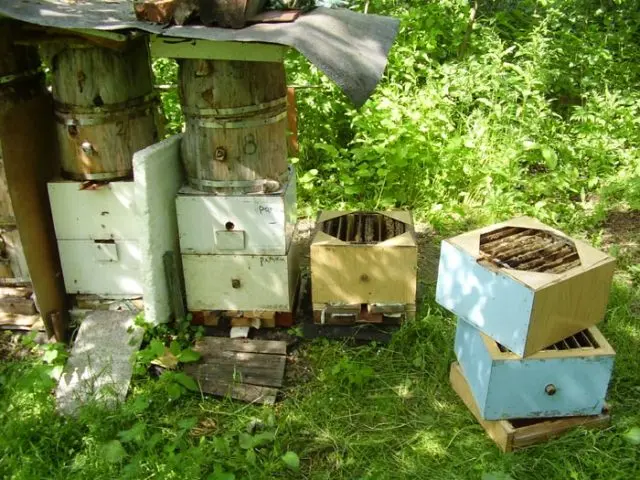Contents
- Modern methods of beekeeping
- The Cebro method
- Kemerovo beekeeping system according to Kashkovsky
- Canadian beekeeping
- Beekeeping for 145 frames
- Contactless beekeeping
- Cassette beekeeping
- Double queen beekeeping
- Beekeeping according to the Malykhin method
- Package beekeeping
- Blinov’s method in beekeeping
- Bortovoe and deck beekeeping
- Conclusion
Double queen keeping of bees has recently gained great popularity, however, this is not the only method of arranging an apiary that has received wide recognition from beginner beekeepers. The old technologies are being replaced every year by more and more new methods of beekeeping, designed to increase the honey yield, however, there is no ideal one among them. Each has its own advantages and disadvantages, therefore, when choosing one or another beekeeping method, it is important to focus on local climatic conditions, the type of bees in the apiary and the structure of the hives.
Modern methods of beekeeping
Almost all modern methods of beekeeping are aimed at achieving the following goals:
- strengthening bee colonies through breeding work;
- providing bees with a sufficient amount of food without losing the honey collection for sale (the amount of collected honey should be enough for both the beekeeper and insects);
- ensuring safe wintering of bees.
In other words, each method of beekeeping somehow implies an increase in the profitability of the apiary.
Classification of beekeeping methods
When choosing a beekeeping method, it is important to consider its main purpose. All ways of organizing life in the apiary are usually classified in the following areas:
- increase in honey collection;
- breeding of a bee colony;
- an increase in the total number of worker bees, especially towards the beginning of the honey collection;
- improving the safety of wintering;
- preventing swarming;
- protection of the queen bee.
The Cebro method
The method is named after its author, the famous amateur beekeeper V.P. Cebro. Beekeeping according to its technology provides for increasing the productivity of bees to the maximum possible limits. All work is carried out strictly according to the calendar schedule.
The main provisions of beekeeping according to Cebro:
- The bees are kept in three-hull type hives with a large volume.
- In the spring, during the growth of bee colonies, store inserts are not removed. Instead, a second building is being completed.
- Weak families of bees are culled, leaving only strong and healthy families in the apiary.
- On the 14th day of development of the bee queen cell, preferably on a late flow, it is recommended to create 2-3 layers and organize a new bee family.
- Immediately after the bribe, the formed layers are combined with the main family. The queen bee is removed.
- To increase honey collection, bees need to ensure the most comfortable wintering. To do this, insects are fed with high-quality complete feed and good ventilation of the hives is provided. Double-hued hives are best suited for wintering, where a store is placed below and a nesting frame is placed on top.

The advantages of beekeeping according to the Cebro method include minimal death after wintering and the absence of swarming. There are no obvious shortcomings.
Kemerovo beekeeping system according to Kashkovsky
Beekeeping according to the method of V. G. Kashkovsky in many regions of the country replaced the traditional Soviet system in the 50s of the 20th century. The prerequisite for such a transition was the laboriousness and significant time costs of the old technology: it was necessary to frequently inspect bee hives, reduce and expand nests in one frame. In this regard, the department of the beekeeping agricultural station of the Kemerovo region began to develop a new method, the purpose of which was to simplify the care of bees and increase the honey yield by 2-3 times.
The basis of the Kemerovo beekeeping system is the following provisions:
- Strong families of bees are kept on wide streets (up to 1,2 cm), and in the spring they are not reduced. Also, combs not inhabited by bees are not removed from the hive.
- The procedures for inspecting and disassembling bee hives are reduced to 7-8 times a season.
- In production, fistulous queens are used. This greatly reduces the amount of work on breeding and replanting queens.
The advantage of this method of beekeeping is the possibility of keeping a large number of unrelated queens in the apiary. The disadvantages of some beekeepers include the need to break out extra queen cells.
Canadian beekeeping
Canadian beekeepers use bee breeding methods to maximize honey production and improve insect immunity. When organizing the life of bees in the apiary, they adhere to the following rules:
- Bees are fed in autumn with maple syrup. Top dressing is introduced starting from the end of August, and the syrup is necessarily diluted with Fumagillin. The drug strengthens the immunity of bees, as a result of which they get sick less often.
- Winters in Canada are severe, so Canadian beekeepers close the hives in October. Wintering takes place in one building, where the bees form a dense ball and thus spend the winter.
- Canadians do not consider spring swarming a big problem. If the bees occupy 9 frames, then it is recommended to add a store and a dividing grid to the hive. In no case should the hives be allowed to overflow. To do this, it is necessary to install store extensions in them in advance to increase the honey collection.
- Queens are usually replaced every 2 years. The replacement of old individuals is carried out only in the presence of young queens, which is possible from June to the end of August.
Pros of the Canadian beekeeping method:
- easy wintering;
- increased honey collection;
- excellent immunity of bees.
You can learn more about beekeeping in Canada from the video below:
Beekeeping for 145 frames
Recently, beekeeping technology is gaining more and more popularity, in which bees are kept in low-wide hives on a frame 145 mm high. The idea of creating a new type of hives first came up with the American K. Farrar, who is considered the founder of this method of beekeeping.
The hive for the 145th frame is a structure of the main box, removable bottom, roof and liner. There are 12 cases and 4 brood extensions for 2 frames.
Features of keeping bees on the 145th frame:
- In the spring, after a clearing flight, the bees are put out of the winter hut. Then the bottoms of the hives are replaced.
- When warm weather sets in, the nests are reduced. Winter brood is replaced with foundation.
- After 2-3 days, the uterus is moved to the lower part of the hive and a Hahnemannian lattice is placed. When the brood is sealed, layers are made from above for the mother liquor.
- At the end of April, the honeycomb body is installed under the dividing grid.
- During the period of pollen collection, pollen collectors are set up.
- Honey is collected immediately after the bribe.
- Weak colonies are culled and not allowed to winter.
Benefits of beekeeping per 145 frame:
- hive compactness;
- the ability to rearrange the body, facilitating the adaptation of bees after wintering;
- accessibility to work with parts of the structure.
Contactless beekeeping
Non-contact beekeeping is considered to be the most humane in relation to insects and as close as possible to their natural way of life. Sometimes the method of non-contact beekeeping is even called natural. Adherents of this technology are convinced that this is the only way to get pure healing honey without any food additives, chemicals and antibiotics.
The basis of this method of breeding bee colonies is the placement of insects in hives-decks USH-2, the structure of which resembles tree hollows – places where bees settle in the wild. This method was popularized by V. F. Shapkin, who created a new type of hive, having previously studied the ancient beekeeping. According to him, bees do not need human control in order to fruitfully produce honey, so interference in their lives should be kept to a minimum.
The USh-2 type hive consists of a combined bottom, 4-6 buildings and a roof. The internal cross-section of the hive should not be less than 30 cm. The internal arrangement of the hive encourages the bees to place their honey storage and brood at the bottom of the structure, just as they do in the wild. When there is not enough space, insects climb under the notch. Ultimately, the breeding of bees in USh-2 using the non-contact method of beekeeping allows you not to disturb the bee colony once again during chores (pumping honey, for example).

When the apiary is prepared for winter using this method, it is enough to leave 18-20 kg of honey.
The advantages of beekeeping according to the Shapkin method in such a hive are as follows:
- simplicity of design;
- multi-tiered content;
- good indicators of thermal insulation of the bee dwelling;
- the ability to work with separate buildings;
- the ability to keep bees in the winter in the wild;
- facilitation of the process of nomadism;
- the ability to use standard frames;
- bee swarming control;
- the availability of household work, in which there is no direct contact with bees – at any time of the year, you can remove the combined bottom from the USh-2 hive, clean it from deadness or replace it.
The small cross-sectional size of the hive is sometimes cited as a disadvantage of non-contact beekeeping. With such parameters, it is difficult to breed a large strong family.
Cassette beekeeping
Cassette beekeeping is based on the placement of bees in lightweight compact versions of conventional hives. In appearance, the cassette pavilion resembles an elongated chest of drawers with small drawers, each of which represents a separate bee house.
Advantages of cassette beekeeping:
- Bees can live in such a dwelling all year round. In this regard, there is no need for the cost of special storage for combs, installation of winter huts and seasonal transportation of hives.
- The productivity of the apiary increases by 2-3 times, especially when installing a mobile cassette pavilion for bees. The honey collection increases due to the movement of bee families from one honey collection base to another.
- Saving space, which is especially important when doing beekeeping in the country.
The cassette method of beekeeping also has disadvantages. For example, during prolonged rains, the cassette pavilion can become damp, and debris accumulates at the bottom of the structure.
Double queen beekeeping
Double queen bee keeping is a method of beekeeping in which insects live in dadans or multi-hull hives, while working individuals from two brood families interact through connecting paths. Both families are equal.
The dwellings of bees are equipped with 16 frames, separated by a lattice. Each bee colony has 8 frames at its disposal. In summer, a magazine insert is attached to the hive.
Advantages of double queen keeping of bees in multi-hull hives or dadans:
- bees hibernate more easily due to a larger number of individuals (it is easier for insects to warm each other);
- the cost of food for bees is lower;
- colonies of bees become stronger;
- the intensity of oviposition of the uterus increases.
The disadvantages of keeping bees with two queens include high costs for hives, difficulty in working with bulky structures and poor ventilation of dwellings – in such conditions, bees can start swarming.
Beekeeping according to the Malykhin method
V. E. Malykhin created his own method of beekeeping based on the technology of brood regulation and reproduction using a special insulator.
Key points:
- At the end of the season, two uteruses are placed in the insulator: a fetal and a duplicate.
- Two or more queens can winter together.
- In the autumn, they get rid of protracted broods.

The main advantage of this method of beekeeping is that the bee colony can heal itself on its own.
Package beekeeping
Package beekeeping is a form of bee breeding in which families are sent in packages to other farms, after which they are destroyed. The method of batch beekeeping is very popular in regions with overhead wintering and a good honey base. Instead of spending money on organizing a comfortable wintering of bees, in such climatic conditions it is easier to buy new bee packages produced in the Southern regions every year.
Benefits of package beekeeping:
- high yield of marketable honey;
- no need for autumn and spring revisions, as well as other seasonal apiary work (installation of a winter hut, bringing bees into a winter hut, clearing the point from snow);
- the possibility of using hives with thin walls, which simplifies the work in the apiary.
The main disadvantage of this method of beekeeping is the high cost of annual purchase of bees.
Blinov’s method in beekeeping
The method of beekeeping, based on the technology of A. Blinov, is aimed at ensuring the safe wintering of bees and creating optimal conditions for growing brood in the spring, when the bee colony is weakened after winter.
The essence of the method is as follows:
- In early spring, it is necessary to reduce the nest of the bee family. To do this, leave half the frames than bees usually settle in. The rest of the frames are carried away behind the dividing wall.
- In the rebuilt nest, the queen does not form compact brood, which makes it easier for the bees to warm it. Thanks to this, they spend less energy and feed, which allows to increase the productivity of the apiary.
- After 15 days, they begin to gradually move the septum as the uterus sows the next frame.
The method of beekeeping according to A. Blinov is most effective only when used on weak colonies of bees. Strong colonies do an excellent job with all the brood laid by the queen.
Bortovoe and deck beekeeping
As the name implies, the deck method of organizing an apiary involves placing bee colonies in decks. When using deck beekeeping, honey is collected only once a year. As a result, honey collection indicators are insignificant, however, the time spent on its extraction is also much less. In addition, the quality of honey in deck beekeeping is always higher than in frame beekeeping.

As for wild beekeeping, it is the oldest, wild form of beekeeping. This is a system in which bee colonies live in natural or artificially hollowed out hollows. Of course, bees are rarely bred this way these days, when there are many more efficient ways to produce honey. In particular, deck beekeeping is much more convenient than beekeeping: the apiary is concentrated in one place, there is no need to regularly go into the forest and climb trees.
The advantages of deck beekeeping in comparison with frame beekeeping include the following points:
- The deck is much stronger than composite structures.
- Making a deck is very easy. Enough basic knowledge in carpentry.
- In winter, decks retain heat more efficiently.
- In the spring, it is more convenient to remove the deadness from the deck.
Cons: the decks are not transportable, and the possibility of affecting the bees is minimal.
Conclusion
The double queen keeping of bees, as well as other methods of beekeeping, are aimed at increasing the efficiency of the apiary. Some methods are distinguished by a humane approach to bees, others mean, first of all, obtaining the maximum possible amount of honey. The most important thing when choosing a particular method is not to forget that in different areas and with different breeds of bees, you can get completely different results.









